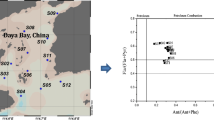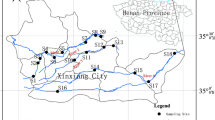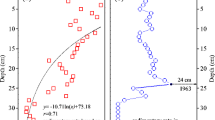Abstract
Polycyclic aromatic hydrocarbons (PAHs) in coastal surface sediments from Rizhao offshore area were analyzed by gas chromatography–mass spectrometry. A chemical mass balance (CMB) model developed by the U.S. Environmental Protection Agency (EPA), CMB8.2, was used to apportion sources of PAHs. Seven possible sources, including coal residential, coal power plant, diesel engines exhaust, gasoline engines exhaust, coke oven, diesel oil leaks, and wood burning, were chosen as the major contributors for PAHs in coastal surface sediments. To establish the fingerprints of the seven sources, source profiles were collected from literatures. After including degradation factors, the modified model results indicate that diesel oil leaks, diesel engines exhaust, and coal burning were the three major sources of PAHs. The source contributions estimated by the EPA’s CMB8.2 model were 9.25%, 15.05%, and 75.70% for diesel oil leaks, diesel engines exhaust, and coal burning, respectively.
Similar content being viewed by others
References
Behymer, T. D., & Hites, R. A. (1988). Photolysis of polycyclic aromatic hydrocarbons adsorbed on fly ash. Environmental Science & Technology, 22(11), 1311–1319. doi:10.1021/es00176a011.
Bzdusek, P. A., & Christensen, E. R. (2004). Source apportionment of sediment PAHs in Lake Calumet, Chicago: Application of factor analysis with nonnegative constraints. Environmental Science & Technology, 38(1), 97–103. doi:10.1021/es034842k.
Christensen, W. F., & Gunst, R. F. (2004). Measurement error models in chemical mass balance analysis of air quality data. Atmospheric Environment, 38(5), 733–744. doi:10.1016/j.atmosenv.2003.10.018.
Friedlander, S. K. (1981). New developments in receptor modeling theory. In E. S. Macias & P. K. Hopke (Eds.), Atmospheric aerosol: Source/air quality relationships (pp. 1–19). Washington, DC: American Chemical Society.
Gordon, G. E. (1988). Receptor models. Environmental Science & Technology, 22(10), 1132–1142. doi:10.1021/es00175a002.
Greenfield, B. K., & Davis, J. A. (2004). A simple mass balance model for PAH fate in the San Francisco Estuary. Oakland, USA: San Francisco Estuary Institute.
Gu, S. H., Kralovec, A. C., Christensen, E. R., et al. (2003). Source apportionment of PAHs in dated sediments from the Black River, Ohio. Water Research, 37(9), 2149–2161. doi:10.1016/S0043-1354(02)00584-5.
Kennicutt, M. C., II, Wade, T. L., Presley, B. J., et al. (1994). Sediment contaminants in Casco Bay, Maine: inventories, sources, and potential for biological impact. Environmental Science & Technology, 28(1), 1–15. doi:10.1021/es00050a003.
Khalili, N. R., Scheff, P. A., & Holsen, T. M. (1995). PAH source fingerprints for coke ovens, diesel and gasoline engines, highway tunnels and wood combustion emissions. Atmospheric Environment, 29(4), 533–542. doi:10.1016/1352-2310 (94)00275-P.
Kim, G. B., Maruya, K. A., Lee, R. F., et al. (1999). Distribution and sources of polycyclic aromatic hydrocarbons in sediments from Kyeonggi Bay, Korea. Marine Pollution Bulletin, 38(1), 7–15. doi:10.1016/S0025-326X (98)00077-0.
Li, A., Jang, J. K., & Scheff, P. A. (2003). Application of EPA CMB8.2 model for source apportionment of sediment PAHs in Lake Calumet, Chicago. Environmental Science & Technology, 37(13), 2958–2965. doi:10.1021/es026309v.
Li, K., Christensen, E. R., Van Camp, R. P., et al. (2001). PAHs in dated sediments of Ashtabula River, Ohio, USA. Environmental Science & Technology, 35(14), 2896–2902. doi:10.1021/es001790f.
Li, Q. (2006). Study on analysis and source apportionment of polycyclic aromatic hydrocarbons on atmospheric particulate of Jinan. Jinan, China: Shandong University (in Chinese).
Lin, X. M., Liu, W. X., Chen, J. L., et al. (2005). Distribution and ecological risk assessment of polycyclic aromatic hydrocarbons in surface sediments from Bohai Sea, China. Acta Scientiae Circumstantiae, 25(1), 70–75 (in Chinese).
Lin, Z., Mai, B. X., Zhang, G., et al. (1999). Quality assurance/quality control in quantitative analysis of polycyclic aromatic hydrocarbons and organochlorine pesticedes in sediments. Environmental Chemistry, 18(2), 115–121 (in Chinese).
Liu, W. L. (2000). Study on source apportionment of polycyclic aromatic hydrocarbons on atmospheric particles in Tangshan city. Tianjin, China: Nankai University (in Chinese).
Mackay, D., & Hickie, B. (2000). Mass balance model of source apportionment, transport and fate of PAHs in Lac Saint Louis, Quebec. Chemosphere, 41(5), 681–692. doi:10.1016/S0045-6535(99)00486-5.
Mackay, D., Shiu, W. Y., Ma, K. C., et al. (1992). Illustrated handbook of physical–chemical properties and environmental fate for organic chemicals. Chelsea, Michigan, USA: Lewis.
Neff, J. M. (1979). Polycyclic aromatic hydrocarbons in the aquatic environment: Source, fates and biological effects. London, UK: Applied Science.
Nemr, A. E., & Said, T. O., et al. (2007). The distribution and sources of polycyclic aromatic hydrocarbons in surface sediments along the Egyptian Mediterranean coast. Environmental Monitoring and Assessment, 124(1–3), 343–359. doi:10.1007/s10661-006-9231-8.
Pistikopoulos, P., Masclet, P., & Mouvier, G. (1990). A receptor model adapted to reactive species: Polycyclic aromatic hydrocarbons; evaluation of source contributions in an open urban site—I. particle compounds. Atmospheric Environment, 24(5), 1189–1197.
Rooney, T. P. (2001). Source apportionment of atmospheric deposition of polycyclic aromatic hydrocarbons at Massachusetts bay using the chemical mass balance model. Lowell, Massachusetts, USA: University of Massachusetts Lowell.
Song, C. L., Wang, H., Tu, X. F., et al. (2000). Study on the emission regularities of polycyclic aromatic hydrocarbons from diesel engine. Automobile Technology, 4, 11–13 (in Chinese).
Su, M. C., & Christensen, E. R. (1997). Apportionment of source of polychlorinated dibenzo-p-dioxins and dibenzofurans by a chemical mass balance model. Water Research, 31(12), 2935–2948. doi:10.1016/S0043-1354(97)00149-8.
Su, M. C., Christensen, E. R., & Karls, J. F. (1998). Determination of PAH sources in dated sediments from Green Bay, Wisconsin, by a chemical mass balance model. Environmental Pollution, 99(3), 411–419. doi:10.1016/S0269-7491 (97)00182-6.
Su, M. C., Christensen, E. R., Karls, J. F., et al. (2000). Apportionment of polycyclic aromatic hydrocarbon sources in lower Fox River, USA, sediments by a chemical mass balance model. Environmental Toxicology and Chemistry, 19(6), 1481–1490. doi:10.1897/1551-5028 (2000)019<1481:AOPAHS>2.3.CO;2.
Tian, Y., Zheng, T. L., & Wang, X. H. (2004). Concentration, distribution and source of polycyclic aromatic hydrocarbons in surface sediments of Xiamen western harbour. Oceanologia et Limnologia Sinica, 35(1), 15–20 (in Chinese).
U. S. Environmental Protection Agency (2004). CMB8.2 user’s manual. Research Triangle Park, NC: Office of Air Quality Planning and Standards.
Yu, G. G., Wang, T. G., & Wu, D. P. (2007). Study on fingerprints of PAHs from the combustion of bavin and coal. Ecology and Environment, 16(2), 285–289 (in Chinese).
Zhu, X. L., Liu, W. L., Lu, Y. Y., et al. (2001). Study on the characteristics of PAHs source profile of coal combustion. Research of Environmental Sciences, 14(5), 4–8 (in Chinese).
Author information
Authors and Affiliations
Corresponding author
Rights and permissions
About this article
Cite this article
Xue, L., Lang, Y., Liu, A. et al. Application of CMB model for source apportionment of polycyclic aromatic hydrocarbons (PAHs) in coastal surface sediments from Rizhao offshore area, China. Environ Monit Assess 163, 57–65 (2010). https://doi.org/10.1007/s10661-009-0816-x
Received:
Accepted:
Published:
Issue Date:
DOI: https://doi.org/10.1007/s10661-009-0816-x




